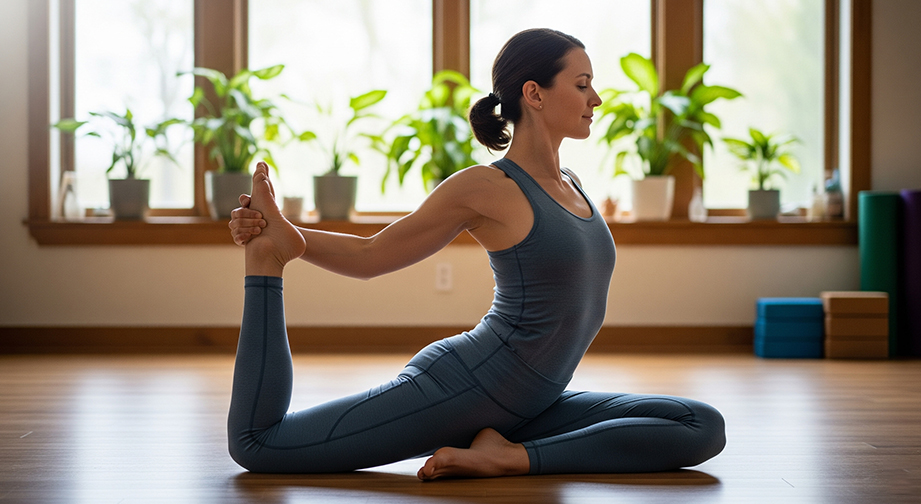Kraunchasana (Heron Pose): Step-by-Step Guide, Benefits, and Mindful Practice Tips
Introduction
Kraunchasana, also known as the Heron Pose, is a calming and stretching yoga posture that gently opens up your hamstrings, hips, and back. In Sanskrit, Krauncha means "heron" (the graceful water bird), and asana means "pose" or "seat." This asana captures the elegant stillness of a perched heron—steadfast, balanced, and poised.
Essence: Calming and lengthening.
If you've ever felt stiff after sitting too long—especially in your legs or back—this pose is your new best friend!
Step-by-Step Guide: How to Practice Kraunchasana (Heron Pose)

- Begin Seated: Sit on your yoga mat with your legs extended straight in front (Dandasana/Staff Pose).
Breathe evenly for a few moments.
- Bend One Knee: Fold your left leg so the heel comes close to your left hip, with the shin and top of the foot resting on the floor (like in Ardha Virasana/Half Hero Pose).
Inhale calmness; exhale tension.
- Lift the Right Leg: Gently bend your right knee, clasp the sole of your right foot with both hands or loop a strap around your foot.
Inhale as you prepare and lengthen your spine.
- Straighten the Leg: On an exhale, gently extend your right leg upward, aiming to straighten it. Keep your elbows soft, and bring the leg as close to your torso as comfortable.
Inhale, lengthen the backbone; exhale, soften the shoulders.
- Hold & Breathe: Keep your spine tall, shoulders relaxed, and gaze softly forward or up at the foot.
Breathe gently and steadily for 3–5 breaths (around 30–60 seconds).
- Release Gently: On an exhale, slowly lower your leg and return to start.
Repeat on the opposite side.
Modifications & Intensifications
- For Beginners: Use a yoga strap around your foot if you can’t easily clasp your hands.
- For Tighter Hips/Knees: Sit on a folded blanket or block to ease hip tension.
- For Advanced Practice: Work on bringing the leg closer to the torso and keeping the back as straight as possible. Hold for up to 10 breaths or add a forward fold, bringing your chin towards your shin.
Alignment & Safety Tips
- Key Alignment: Keep your spine long, shoulders down, and chest lifted.
- Common Mistakes:
- Rounding the back—keep it upright and gently engaged.
- Locking the knee—micro-bend the extended leg if needed.
- Collapsing the chest—maintain an open, proud heart center.
- Safety Tips:
- Never force the leg straight—it’s fine to keep it bent!
- Avoid if you have knee injuries, tight hamstrings, or recent hip surgery.
- Skip if pregnant or if you experience sharp pain in knees or lower back.
Benefits of Kraunchasana (Heron Pose)
Physical Benefits
- Stretches hamstrings, calves, and hips
- Strengthens back and improves posture
- Enhances ankle mobility
- Promotes flexibility in legs and spine
Mental Benefits
- Calms the mind and relieves stress
- Boosts focus through mindful breathing
- Encourages patience and self-acceptance
Energy/Chakra Connection
- Activates the Root (Muladhara) and Sacral (Svadhisthana) Chakras
- Helps ground and balance emotional energy
Contraindications
- Hamstring or knee injuries
- Recent hip or lower back surgery
- Pregnancy
- Severe sciatica
Alternative Poses: Supta Padangusthasana (Reclining Hand-to-Big-Toe Pose) or gentle Seated Forward Fold (Paschimottanasana) with bent knees.
Beginner’s Tips & Variations
- Props: Use a strap if reaching your foot is difficult, or sit on extra padding for support.
- Gentle Variation: Keep your extended leg bent and hold under your knee or shin.
- Wall Support: Practice with your back against a wall to maintain upright posture.
- Advanced Variation: Deepen the forward fold or try to touch your chin to your shin.
How to Include Kraunchasana in a Yoga Flow
- Best as a main practice posture, or in the cool-down/stretching phase
- Pairs well with:
- Janu Sirsasana (Head-to-Knee Pose)
- Paschimottanasana (Seated Forward Fold)
- Baddha Konasana (Bound Angle Pose)
Mind-Body Connection
While practicing Kraunchasana (Heron Pose), focus on your breath and observe the sensations in your body as your leg lengthens. This mindful attention fosters not only physical release, but also a profound sense of calm—and in yogic tradition, gently awakens and balances your root and sacral chakras, supporting both stability and creativity.
Asana Name: Heron Pose (Kraunchasana)
Level: Intermediate
Focus Areas: Hamstrings, hips, back
Duration: 30–60 seconds per side, 1–2 rounds
Best Time to Practice: Morning or evening, after light warm-up
Frequently Asked Questions
Q: Is Kraunchasana safe for beginners?
A: With props (like straps and blankets), beginners can safely explore gentle versions of the Heron pose. Honor your body's limits and build up slowly.
Q: My hamstrings are very tight! What should I do?
A: It's absolutely okay to keep your knee bent or use a strap. Over time, your flexibility will increase.
Q: Can I practice Kraunchasana daily?
A: Yes, Kraunchasana can be practiced regularly if done with awareness and within your comfort range. Always listen to your body!
If you’re looking for a gentle yet powerful way to stretch your legs and calm your mind, Kraunchasana (Heron Pose) might become your go-to posture on the mat. Enjoy, breathe, and feel the elegance of the heron flow through you!